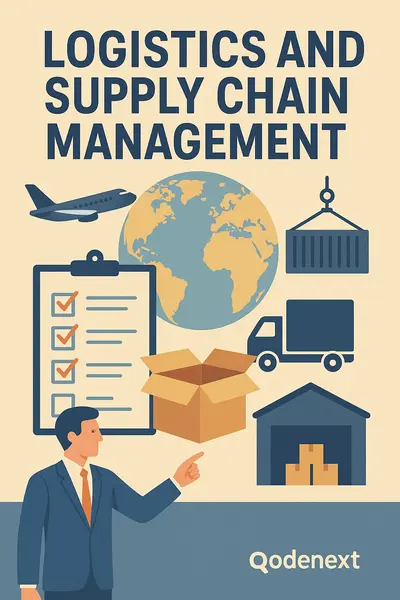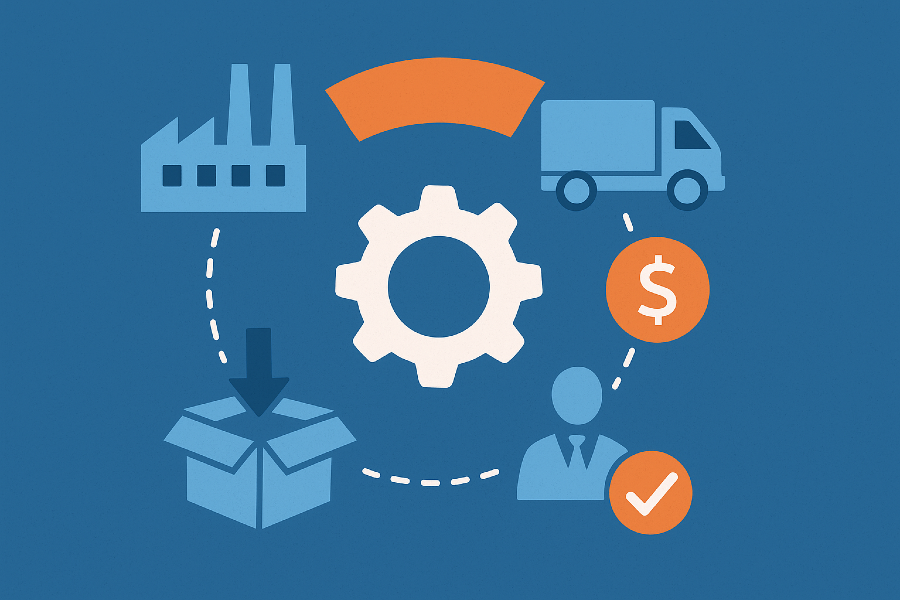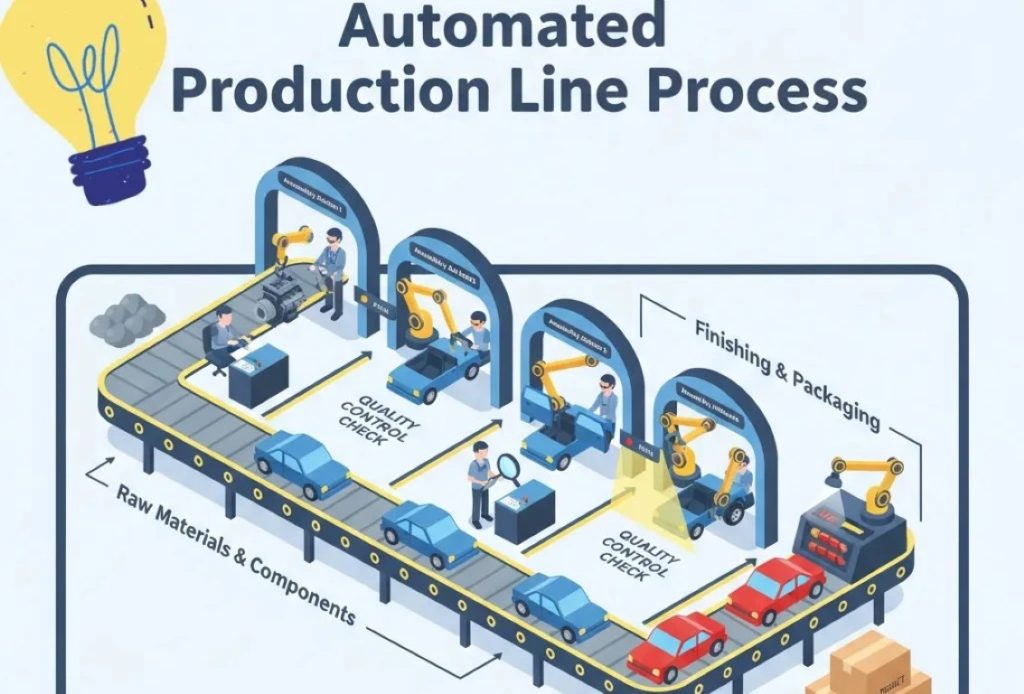
In the dynamic landscape of ecommerce, effective supply chain management is pivotal for success. Supply chain mapping, a strategic process that visualizes the entire supply chain from raw materials to end consumers, has emerged as a game-changer for businesses. This article delves into the multifaceted world of supply chain mapping, exploring its definition, tools, processes, and the myriad benefits it offers to ecommerce enterprises. From enhancing efficiency to fostering transparency, the advantages are manifold. Join us on a journey through the intricacies of supply chain mapping and discover how it can revolutionize the way ecommerce businesses operate.
Supply Chain Mapping Tool
In today’s dynamic business environment, optimizing the supply chain is crucial for staying competitive. A Supply Chain Mapping Tool emerges as an indispensable asset, empowering businesses to streamline operations, mitigate risks, and foster collaboration across the entire supply network.
Introduction:
In the realm of modern business, where global connectivity is paramount, a Supply Chain Mapping Tool has become instrumental in providing organizations with a holistic view of their supply networks. This tool acts as a comprehensive solution for visualizing, analyzing, and optimizing the intricate web of processes involved in the supply chain.
Benefits of Supply Chain Mapping:
Employing a Supply Chain Mapping Tool brings forth a multitude of benefits. It allows businesses to identify bottlenecks, enhance transparency, and make informed decisions. Moreover, by offering real-time insights, this tool facilitates proactive risk management and ensures a resilient supply chain.
Enhanced Visibility:
One of the primary advantages of a Supply Chain Mapping Tool is the enhanced visibility it provides. By mapping each step of the supply chain, businesses can gain a clear understanding of their processes, helping them identify inefficiencies and areas for improvement.
Risk Mitigation:
In the volatile world of global commerce, understanding and mitigating risks is paramount. A Supply Chain Mapping Tool enables organizations to identify potential vulnerabilities, whether they be related to geopolitical events, natural disasters, or supplier issues, allowing for proactive risk management strategies.
Collaboration and Communication:
Collaboration is key in a complex supply chain. The mapping tool acts as a centralized platform, fostering communication and collaboration among various stakeholders. It enables seamless sharing of information, thus promoting better coordination and efficiency.
Cost Optimization:
With a Supply Chain Mapping Tool, businesses can identify unnecessary costs and inefficiencies in their processes. By streamlining the supply chain, organizations can optimize costs, enhance resource allocation, and ultimately improve their bottom line.
Scalability:
As businesses grow, so does the complexity of their supply chains. A Supply Chain Mapping Tool ensures scalability by providing a flexible framework that can adapt to changes in the business landscape. This adaptability is essential for accommodating growth and evolving market dynamics.
The implementation of a Supply Chain Mapping Tool is a strategic imperative for businesses aiming to thrive in today’s fast-paced and interconnected world. By incorporating this tool into their operations, organizations can achieve heightened visibility, mitigate risks, enhance collaboration, and ultimately optimize their supply chain for sustained success.
Supply Chain Mapping Definition
In the realm of modern business, where intricacies of global trade interlace with dynamic market demands, the concept of Supply Chain Mapping stands as a pivotal strategic tool. Supply Chain Mapping can be defined as a comprehensive process of visualizing, understanding, and documenting the entire network of activities, entities, and resources involved in delivering a product or service from the supplier to the end consumer. This strategic approach is designed to enhance operational efficiency, mitigate risks, and foster collaboration across the supply chain ecosystem.
Key Pointers:
Visualization of Network Dynamics:
At its core, Supply Chain Mapping involves the graphical representation of the entire supply chain network. This visualization encapsulates suppliers, manufacturers, distributors, and retailers, offering a bird’s-eye view of the flow of goods and information.
Identification of Stakeholders:
Through Supply Chain Mapping, businesses can pinpoint every stakeholder within the supply chain. This includes suppliers, subcontractors, logistics providers, and end customers. Recognizing these players is fundamental to optimizing communication and collaboration.
Process Transparency:
One of the primary objectives of Supply Chain Mapping is to illuminate each step and process involved in the supply chain journey. From raw material procurement to production, distribution, and retail, understanding each stage fosters efficiency improvements and cost reduction opportunities.
Risk Mitigation:
By thoroughly mapping the supply chain, businesses can identify potential vulnerabilities and risks. This proactive approach allows for the development of contingency plans to mitigate disruptions caused by factors such as natural disasters, geopolitical events, or unexpected market fluctuations.
Enhanced Decision-Making:
Armed with a comprehensive understanding of the supply chain dynamics, decision-makers can make informed choices. Whether it’s optimizing inventory levels, streamlining transportation routes, or selecting reliable suppliers, Supply Chain Mapping provides the data needed for strategic decision-making.
Collaborative Opportunities:
The visibility gained through Supply Chain Mapping opens avenues for collaboration and partnerships. Businesses can identify areas for joint ventures or mutually beneficial initiatives with suppliers and distributors, creating a more integrated and responsive supply chain ecosystem.
Continuous Improvement:
Supply Chain Mapping is not a one-time endeavor but an ongoing process. Regular updates and revisions enable businesses to adapt to evolving market conditions, technological advancements, and changes in consumer behavior, ensuring continuous improvement and resilience.
Technological Integration:
In the digital era, leveraging technology such as blockchain, IoT (Internet of Things), and advanced analytics plays a crucial role in enhancing Supply Chain Mapping. These technologies contribute to real-time tracking, transparency, and data-driven insights, further optimizing the entire supply chain process.
Supply Chain Mapping serves as a strategic compass, guiding businesses through the intricate web of global commerce. Its holistic approach not only unravels the threads of efficiency but also weaves a tapestry of resilience and adaptability in the ever-evolving landscape of supply chain management.
Importance Of Supply Chain Mapping
In the intricate web of modern business operations, supply chain mapping emerges as a critical tool for companies striving to enhance their operational efficiency. The significance of supply chain mapping cannot be overstated, as it provides a comprehensive view of the entire supply network, from raw material procurement to end-product delivery. This article explores the pivotal role of supply chain mapping and its impact on various aspects of organizational success.
Enhanced Visibility and Transparency:
Supply chain mapping offers companies an unparalleled level of visibility into their entire supply network. By meticulously documenting and visualizing every stage of the supply chain, organizations can identify potential bottlenecks, risks, and inefficiencies. This heightened transparency enables proactive decision-making and risk mitigation strategies.
Risk Mitigation and Resilience:
Understanding the intricacies of the supply chain through mapping allows businesses to identify vulnerabilities and potential risks. By recognizing dependencies on specific suppliers, regions, or transportation modes, companies can develop contingency plans to navigate unforeseen disruptions, such as natural disasters, geopolitical events, or supply shortages. This proactive approach enhances the resilience of the supply chain.
Optimized Resource Allocation:
Supply chain mapping facilitates a detailed analysis of resource usage at each stage of production. This granular insight enables companies to optimize resource allocation, minimize waste, and enhance overall operational efficiency. By identifying redundant processes or excess inventory, organizations can streamline operations and reduce costs.
Improved Collaboration and Communication:
Mapping the supply chain promotes better collaboration and communication among internal departments and external partners. When all stakeholders have a clear understanding of the entire supply network, coordination becomes more efficient. This, in turn, fosters collaboration, reduces lead times, and enhances overall responsiveness to market demands.
Compliance and Regulatory Adherence:
In today’s globalized business environment, adherence to various regulations and compliance standards is paramount. Supply chain mapping helps organizations ensure that each stage of their operations aligns with regulatory requirements. This not only mitigates the risk of legal issues but also enhances corporate social responsibility by promoting ethical and sustainable practices.
Customer Satisfaction and Responsiveness:
A well-mapped supply chain contributes to improved customer satisfaction by ensuring timely and reliable deliveries. With a clear understanding of lead times and potential disruptions, companies can proactively address issues, meet customer expectations, and enhance their reputation in the market.
Strategic Decision-Making:
Supply chain mapping serves as a strategic tool for decision-makers. By having a comprehensive overview of the supply network, executives can make informed decisions related to sourcing, production, and distribution. This strategic decision-making capability contributes to long-term competitiveness and adaptability in dynamic market conditions.
Continuous Improvement and Innovation:
Regularly updating and refining supply chain maps allows organizations to identify areas for improvement and innovation continually. This iterative process fosters a culture of continuous improvement, ensuring that the supply chain remains adaptable and responsive to evolving market dynamics.
The importance of supply chain mapping cannot be overstated in today’s complex business landscape. It serves as a cornerstone for achieving operational excellence, fostering resilience, and driving strategic decision-making. As companies navigate the challenges of the global marketplace, the ability to map and optimize their supply chains becomes a key differentiator for sustained success.
Supply Chain Mapping Benefits
Supply chain mapping is a strategic process that involves visualizing and understanding the entire supply chain from raw material acquisition to end-user delivery. This comprehensive analysis provides businesses with invaluable insights, fostering improved efficiency, transparency, and resilience. Let’s delve into the numerous benefits that supply chain mapping brings to the table.
Enhanced Visibility:
Supply chain mapping provides a panoramic view of the entire supply network, offering stakeholders unprecedented visibility into the flow of goods and information. This heightened transparency enables businesses to identify potential bottlenecks, optimize processes, and make informed decisions.
Risk Mitigation:
One of the critical advantages of supply chain mapping is its role in risk mitigation. By identifying vulnerabilities and dependencies within the supply chain, companies can proactively develop strategies to mitigate risks such as geopolitical disruptions, natural disasters, or supplier issues.
Improved Collaboration:
Supply chain mapping fosters collaboration among different stakeholders, including suppliers, manufacturers, and distributors. By understanding each party’s role and contribution within the supply chain, businesses can establish stronger relationships and streamline communication, leading to increased efficiency.
Cost Optimization:
Mapping the supply chain allows organizations to identify cost-saving opportunities throughout the entire process. By analyzing each step, businesses can pinpoint areas where resources are underutilized or where costs can be reduced, ultimately improving the overall financial performance of the supply chain.
Regulatory Compliance:
Supply chain mapping assists companies in ensuring compliance with various regulations and standards. By understanding the regulatory landscape across different regions, businesses can adapt their supply chain processes to meet legal requirements, avoiding potential fines and disruptions.
Customer Satisfaction:
A well-mapped supply chain leads to enhanced customer satisfaction. Through optimized processes, businesses can ensure timely deliveries, reduce stockouts, and provide accurate information to customers. This positively impacts brand reputation and customer loyalty.
Sustainability:
Supply chain mapping plays a crucial role in promoting sustainability initiatives. By analyzing the environmental impact at each stage of the supply chain, companies can implement eco-friendly practices, reduce their carbon footprint, and meet the growing demand for sustainable business operations.
Continuous Improvement:
Regularly updating and revisiting supply chain maps enables organizations to embrace a culture of continuous improvement. By identifying inefficiencies or emerging opportunities, businesses can adapt and evolve their supply chain strategies to stay competitive in a dynamic market.
In supply chain mapping is a powerful tool that offers a multitude of benefits, from enhanced visibility and risk mitigation to improved collaboration and sustainability. By incorporating supply chain mapping into their strategic initiatives, businesses can unlock new levels of efficiency and resilience, positioning themselves for long-term success in an ever-evolving global marketplace.
Supply Chain Mapping Process
In the dynamic landscape of modern business, mastering the supply chain mapping process is a strategic imperative that can pave the way for operational excellence and heightened resilience. This intricate procedure involves the comprehensive visualization and documentation of every element within a supply chain, from raw material procurement to the delivery of the final product to the end consumer. Let’s delve into the key aspects and essential steps of the supply chain mapping process.
Initiation:
The foundation of effective supply chain mapping lies in initiating the process with a clear understanding of the organization’s objectives. Identify the scope and purpose of the mapping exercise, whether it’s to enhance efficiency, mitigate risks, or optimize costs.
Data Collection:
Unearth the intricate details of your supply chain by collecting data from all relevant sources. This includes supplier information, transportation networks, inventory levels, and production capacities. The more comprehensive the data, the more accurate and insightful the mapping process will be.
Integration of Technology:
Leverage advanced technologies such as blockchain, RFID, and IoT devices to facilitate real-time data capture and integration. This not only enhances the accuracy of the supply chain map but also enables proactive decision-making in response to any disruptions.
Stakeholder Collaboration:
Supply chain mapping is a collaborative effort that involves multiple stakeholders within and outside the organization. Engage with suppliers, logistics partners, and internal teams to gather insights and ensure a holistic representation of the entire supply network.
Risk Assessment:
Identify potential risks at each node of the supply chain and integrate risk mitigation strategies into the mapping process. This proactive approach allows organizations to develop contingency plans, reducing vulnerability to unforeseen disruptions.
Continuous Monitoring:
Supply chain mapping is not a one-time activity but an ongoing process. Implement systems for continuous monitoring and periodic updates to ensure that the map remains reflective of the evolving dynamics in the supply chain.
Performance Metrics:
Integrate key performance indicators (KPIs) into the supply chain mapping process to assess the performance of each component. This enables organizations to identify areas for improvement and optimize resource allocation.
Adaptability:
A resilient supply chain is one that can adapt to changing circumstances. Build flexibility into the mapping process, allowing for adjustments in response to market shifts, regulatory changes, or unforeseen events.
Mastering the supply chain mapping process is not just a strategic advantage but a necessity in the contemporary business landscape. By incorporating advanced technologies, fostering collaboration, and maintaining adaptability, organizations can build robust and responsive supply chains that stand the test of time. The supply chain mapping process is not merely a tool; it is a dynamic framework that empowers businesses to navigate the complexities of the global marketplace with confidence.
Supply Chain Mapping Software
In today’s dynamic business landscape, effective supply chain management is crucial for companies striving to optimize their operational efficiency. Supply chain mapping software emerges as a powerful tool in achieving this goal. This innovative technology allows organizations to gain comprehensive insights into their supply chain processes, identify potential bottlenecks, and streamline operations for enhanced productivity.
Key Features of Supply Chain Mapping Software:
Real-time Visibility:
Supply chain mapping software provides real-time visibility into the entire supply chain network. This enables businesses to monitor the movement of goods, track inventory levels, and identify any disruptions promptly.
Risk Mitigation:
By incorporating supply chain mapping software, companies can proactively identify and mitigate potential risks. The software allows users to assess the impact of external factors such as natural disasters, geopolitical events, or supply chain disruptions, helping organizations implement effective risk management strategies.
Collaboration and Communication:
One of the noteworthy aspects of supply chain mapping software is its ability to facilitate collaboration among different stakeholders. It promotes seamless communication between suppliers, manufacturers, and distributors, fostering a more integrated and responsive supply chain ecosystem.
Optimized Resource Allocation:
Efficient resource allocation is vital for a streamlined supply chain. Supply chain mapping software enables organizations to analyze resource utilization, optimize inventory levels, and minimize excess or obsolete stock, resulting in significant cost savings.
Performance Analytics:
With robust analytics capabilities, supply chain mapping software allows businesses to evaluate the performance of various supply chain components. This data-driven approach empowers organizations to make informed decisions, identify areas for improvement, and implement strategic enhancements.
Compliance Management:
Compliance with regulatory requirements is a critical aspect of supply chain management. Supply chain mapping software helps organizations stay compliant by providing tools to monitor and ensure adherence to relevant industry standards and regulations.
Scalability and Flexibility:
As businesses evolve, their supply chain needs change. Supply chain mapping software is designed to be scalable and adaptable to evolving business requirements. This ensures that the software can grow with the organization, supporting its expansion and adapting to new market dynamics.
In supply chain mapping software emerges as a transformative solution for organizations seeking to optimize their supply chain processes. With real-time visibility, risk mitigation capabilities, enhanced collaboration, and performance analytics, this software empowers businesses to achieve operational excellence. By investing in supply chain mapping software, companies can proactively address challenges, capitalize on opportunities, and build a resilient and efficient supply chain ecosystem.
FAQs: Benefits Of Supply Chain Mapping For Ecommerce Businesses
What is supply chain mapping, and why is it crucial for ecommerce businesses?
Supply chain mapping is a strategic visualization of the entire supply chain, vital for optimizing operations, enhancing transparency, and mitigating risks in ecommerce.
How does the supply chain mapping process unfold?
The process involves identifying key components, mapping relationships, and utilizing technology like Qodenext to create a dynamic visual representation of the supply chain.
What are the key benefits of supply chain mapping for ecommerce businesses?
Benefits include cost reduction, improved customer satisfaction, enhanced agility, risk mitigation, and streamlined operations.
How does supply chain mapping software like Qodenext contribute to the process?
Qodenext facilitates real-time data integration, collaboration, and analytics, empowering businesses to make informed decisions and optimize their supply chain.
Can small-scale ecommerce businesses benefit from supply chain mapping?
Absolutely. Supply chain mapping scales to the needs of businesses, providing small enterprises with tools to enhance efficiency and competitiveness.
Is supply chain mapping a one-time process, or does it require continuous updating?
It requires continuous updates to adapt to changes in the business environment, ensuring the supply chain remains agile and responsive.
How does supply chain mapping contribute to sustainability in ecommerce?
By identifying inefficiencies and optimizing processes, supply chain mapping promotes sustainability through reduced waste, energy efficiency, and ethical sourcing.
Conclusion:
In conclusion, as ecommerce businesses navigate the complexities of the modern market, supply chain mapping emerges as an indispensable tool. With Qodenext leading the charge in innovative solutions, businesses can not only visualize their supply chains but also optimize operations for sustained success. Embrace the power of supply chain mapping, unlock unprecedented efficiency, and propel your ecommerce venture to new heights with Qodenext.







